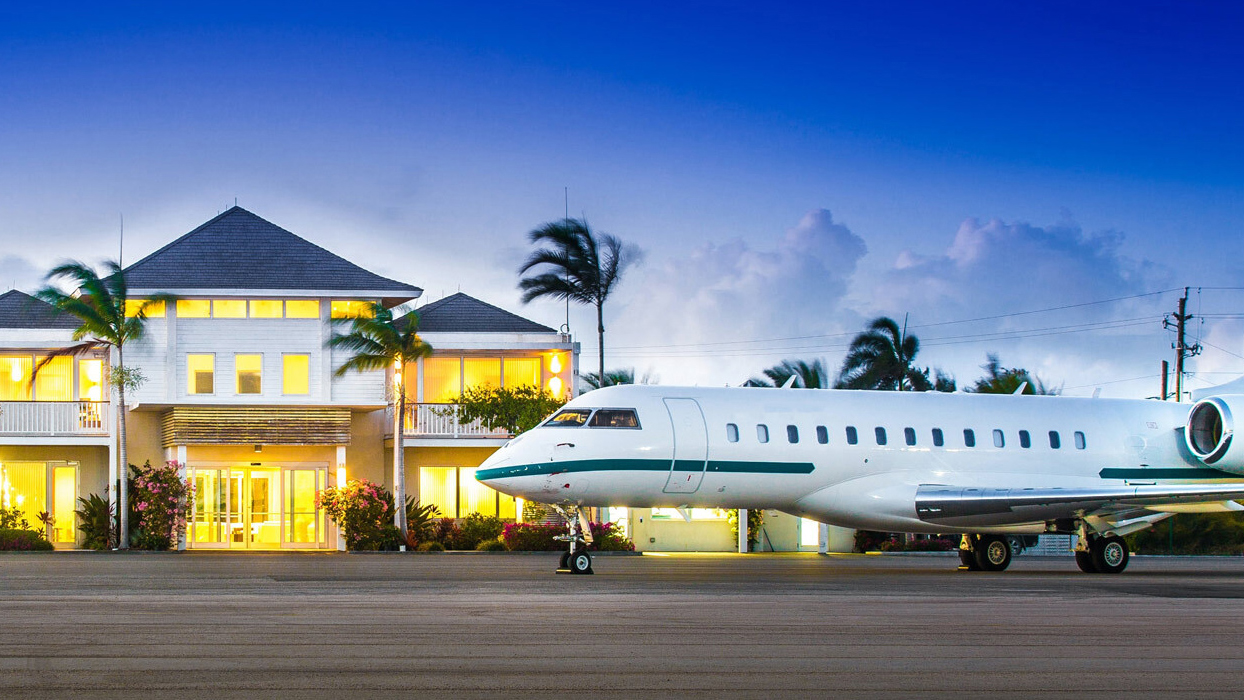When the Provo Air Center (PAC) first opened its doors in 2001, aside from knowledgeable scuba divers, few could place the Turks and Caicos Islands on a map. But these days it has become one of the region’s busiest destinations for private aviation.
Located at Providenciales International Airport, the full-service FBO—one of two service providers on the field—moved into its current 9,350-sq-ft terminal in 2015. “We’re very big on privacy here, so we tried to design the building so that upon arrivals and departures everyone can have their own space,” explained PAC CEO Deborah Aharon, who has been with the company since its founding. “Customers have four different lounges to themselves; we even have a special lounge just for kids with a pirate cave.” Other services and amenities include a large pilot lounge, snooze room with four private rest areas, shower facilities, conference room, laundry, dishwashing, and concierge. “We have the world’s first drive-through customs hall,” said Aharon, adding guests are picked up planeside and whisked inside. “You can stay seated in the golf cart right through the building as you deal with the customs and immigration officers.”
Like many leisure destinations, traffic at the FBO has experienced a post-Covid surge with the past year seeing 1,100 more flights than the period prior to the pandemic lockdown. Between private aircraft and some of the commercial carriers that frequent the airport, the facility pumps approximately 5 million gallons of fuel a year. However during the pandemic, the entire island locked down for three months. While most companies in the suddenly-idle tourism industry began shutting down and laying off employees, PAC eked through after Aharon sought permission to remain open to handle medevac flights or fuel stops. As staffing needs at the FBO declined drastically, the workers requested that nobody be furloughed. “For three months only two people were in the building at a time,” she told AIN. “What little hours there were, they shared them, and then they shared food, they shared information. It was the most amazing thing I have ever seen a group of people do, the way they took care of each other.”
The company has also forged lasting relationships with its clients. The day the country reopened, a regular customer arrived from Europe on his large-cabin jet and delivered a large supply of personal protection equipment (which was unavailable on the island), instructing Aharon to distribute half to her staff and families and give the remainder to the government anonymously. Realizing the hardships the business endured, he then proceeded to give her a check for $25,000 to disburse equally among the staff.
PAC is normally open from 7 a.m. until 7 p.m., but that is not usually the case given the number of after-hours medevac flights and other emergency activities. Several years ago, when the facility’s leading concierge returned to his home in the Philippines, the company decided to take advantage of the time zone change, retaining him as the night concierge, and fielding all overnight handling requests. “We might leave work at 7 p.m. thinking that tomorrow we have 30 planes and when we wake up in the morning and look to see what Don’s done, we have 70,” said Aharon. “If we didn’t have him all through the night, we would be in terrible shape, struggling to catch up.” He will make reservations and process paperwork to be printed out the next morning, and in case of emergencies, is the point of contact to get staff back onsite.
While the facility was built with a fully-equipped kitchen, it wasn’t until the company had to step in to replace the subpar catering at a guest’s meeting that it decided to launch its own in-house catering operation. In the year since it has been running at full throttle, PACKitchen has proven so popular that the company is investing in a $1 million expansion, which will give it separate cold and hot preparation kitchens, as well as adding more staff. Among its most popular offerings are “ready meals,” microwaveable gourmet dinners for crews that arrive late and may not find open restaurants.
While PAC does not have any hangar space, that will change as the company plans to break ground this year on a 29,200-sq-ft structure with a maximum ceiling height of nearly 40 feet, capable of holding a pair of Gulfstream G650s side by side.
Source: AIN Online
 Cessna Citation V
Cessna Citation V



